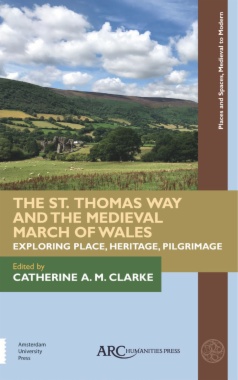The St. Thomas Way is a new heritage route from Swansea to Hereford which invites visitors to step into history of the medieval March of Wales. This multi-faceted volume offers new insights into the story of St. Thomas of Hereford, medieval and modern-day pilgrimage, professional aspects of heritage, tourism and regional development, and the application of digital methods and tools in heritage contexts. It also reflects on the St. Thomas Way as a spiritual and artistic experience.
- Front Cover
- Front matter
- Half-title
- Series information
- Title page
- Copyright information
- Table of contents
- Illustrations
- Preface
- Contributor Biographies
- Body
- Introduction: Remaking medieval pilgrimage—the St. Thomas way
- Section One. Contexts and Critical Explorations
- Chapter 1. Changing Roles of Pilgrimage: Retreating, Remembering, Re-enacting
- What is Pilgrimage?
- Peregrinatio and the Earliest Christian Pilgrimages
- Medieval Pilgrimage in Britain: Destinations and Causes
- The Experience of Pilgrimage
- Conclusion
- Key Reading
- Chapter 2. In the Footsteps of the Past: Medieval Miracle Stories and the St. Thomas Way
- The Medieval Pilgrims
- Swansea
- Longtown
- Kilpeck
- Hereford
- The Themes
- Margam: Learning
- Ewenny: Religious Life
- Llancarfan: Visions
- St. Fagans: Spaces
- Caerphilly: Castles and the March
- Newport: Water/Frontiers
- Usk: Identity
- Abergavenny: Individuals and their Stories
- Patrishow: Popular Devotion
- Conclusion
- Key Reading
- Chapter 3. Place, Time, and the St. Thomas Way: An Experiment in Five Itineraries
- William Cragh: Acts of Faith
- Gerald of Wales: Getting Stuck
- Walter Map’s Familiar Phantoms
- T. S. Eliot and Geoffrey Hill: Playing Pilgrims
- Raymond Williams: Disciplining Time and Place
- Key Reading
- Chapter 4. Archives as Commemoration / Pilgrimage as Interpretation: Hereford Cathedral, The St. Thomas Way, and Cantilupe 2020
- Introduction
- What Do I Mean by Commemoration?
- So What Do I Mean by Archives (and Archivists)?
- Community: Easy to Understand, Hard to Define
- Pilgrimage, Shrines, and Relics
- Commemorating St. Thomas
- Pilgrimage as Interpretation (and Commemoration)
- Conclusion
- Key Reading
- Chapter 5. Heritage Soundscapes: Contexts and Ethics of Curatorial Expression
- Introduction
- The Sound of History
- Sound in Heritage Sites
- Sound as Evocation
- Sound as Re-creation of the Past
- Sound as Artistic Reflection on the Past
- Conclusions
- Key Reading
- Section Two. Other Perspectives
- Chapter 6. Reflection on the St. Thomas Way
- Chapter 7. String Theory for Beginners: The Art of Pilgrimage
- A Cyclical Journey of Making
- Into the Labyrinth…
- String Theory
- String Theory in Practice: Public Engagement
- Measuring to the Saint, Version 2.0
- Remaking Maps of the Mind
- The Art of Pilgrimage
- Are We There Yet? The Journey Continues
- Change the Way You Look at Things and the Things You Look at Change
- Chapter 8. Between the Sea and the Hills: On Walking the St. Thomas Way
- Back matter

